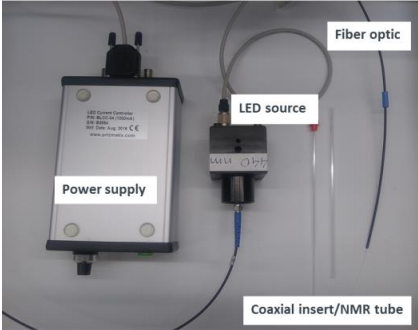Goldstone Scientific Blog

Popular Configurations - Fiber Coupled LED for In Situ NMR Spectroscopy - Updated March 2025
NOTE: Scroll down to see the March 2025 update section with new options One application that is gaining popularity is a fiber coupled LED for NMR Spectroscopy. The set up that most people ask for is a Mic-LED and controller with fiber coupler adapter and a long plastic fiber optic. This set up can be seen in [...]
Light Meters, Fiber Optics and Optogenetics – Part 3 – Prizmatix’s Advice on Light Meters for Optogenetics
I am often asked to recommend light meters to use for testing the fiber optic implants that will be used in Optogenetic experiments. This is important in order to test the quality of each implant and make sure everything is working correctly. Measuring the light correctly is not a trivial matter. The meter setting, the detector and [...]
High NA Fiber Optics for In-Vivo Optogenetics – The Options on Goldstone Scientific
Quality fiber optic implants are crucial for successful in-vivo Optogenetics. Scientists will need to spend time or money (or both) to ensure quality results. Prizmatix offers a range of options and Goldstone Scientific makes it easy to order and offers competitive prices with bulk discounts and fast shipping to save you both. Many items are [...]
Light Meters, Fiber Optics and Optogenetics – Part 2 – Bad Detector Advice
One of our customers was recently shopping for a light meter and detector. I had recommended a particular meter and a detector with a silicone photodiode from a popular vendor. The vendor advised that a detector with a thermal sensor would be better for an LED light source.Our engineers looked at that sensor, and advised it would [...]
Light Meters, Fiber Optics and Optogenetics – Part 1 – Light Meter Blues
Prizmatix LEDs are extremely powerful and our customers are generally very satisfied with their performance. Sometime, however, I get complaints about the power output being lower than expected as per the published specification. Very frequently it turns out that the light source is fine, and the problem lies within the tools and methods used to measure the power. In [...]

High NA Fiber Optics and Collimators; Don’t Shoot Yourself in the Foot
A customer recently complained that the power output of her Prizmatix fiber coupled LED was too low. The LED system was 5 years old and she suspected that the power loss was due to age. She wrote: I'm using a Prizmatix FC8-LED fiber coupled multi-channel LED source, along with a fiber that we purchased from you. This fiber is attached to a custom-made [...]

Understanding Prizmatix Model Names – A concise guide
Prizmatix recently updated their model names and part numbers to make it easier to understand which model fits which application. This guide will help you understand what each section of the part number means. UHP – Any light source model with UHP is Ultra High Power. This means that the LED chip is being driven with an electrical current [...]

Prizmatix Fiber Optic Rotary Joint; Compatibility of with Lasers or other light sources
The Prizmatix Fiber Optic Rotary Joint is an important part of the Prizmatix In-Vivo Optognetics Toolbox. It’s extremely low torque (<10μNm) allows even the smallest animals to move freely and its high transmission is helpful in getting as much power as possible to the target. One really nice feature of the Prizmatix fiber optic rotary joint is that it can be used [...]

In-Line Filters and Prizmatix Fiber Coupled LEDs
A customer just ask me about an in-line filter holder for the fiber coupled Prizmatix Silver-LED. He had a model chosen from another vendor. I offered him two possible alternatives. Option One – Save Money Make an in-line filter with two Prizmatix fiber coupling adapters back to back with a short SM1 tube and an internal thread between them to hold a [...]

Do LEDs have enough power for In-Vivo Optogenetics?
Do LEDs have enough power for In-Vivo Optogenetics? It depends who you ask. Often, while talking to researchers considering LED for Optogenetics, I hear “People tell me that LEDs just don’t have enough power, especially for inhibition”. That is a real concern. In fact a competing vendor of LEDs for Optogenetics told me that their light sources do not have enough power, [...]
